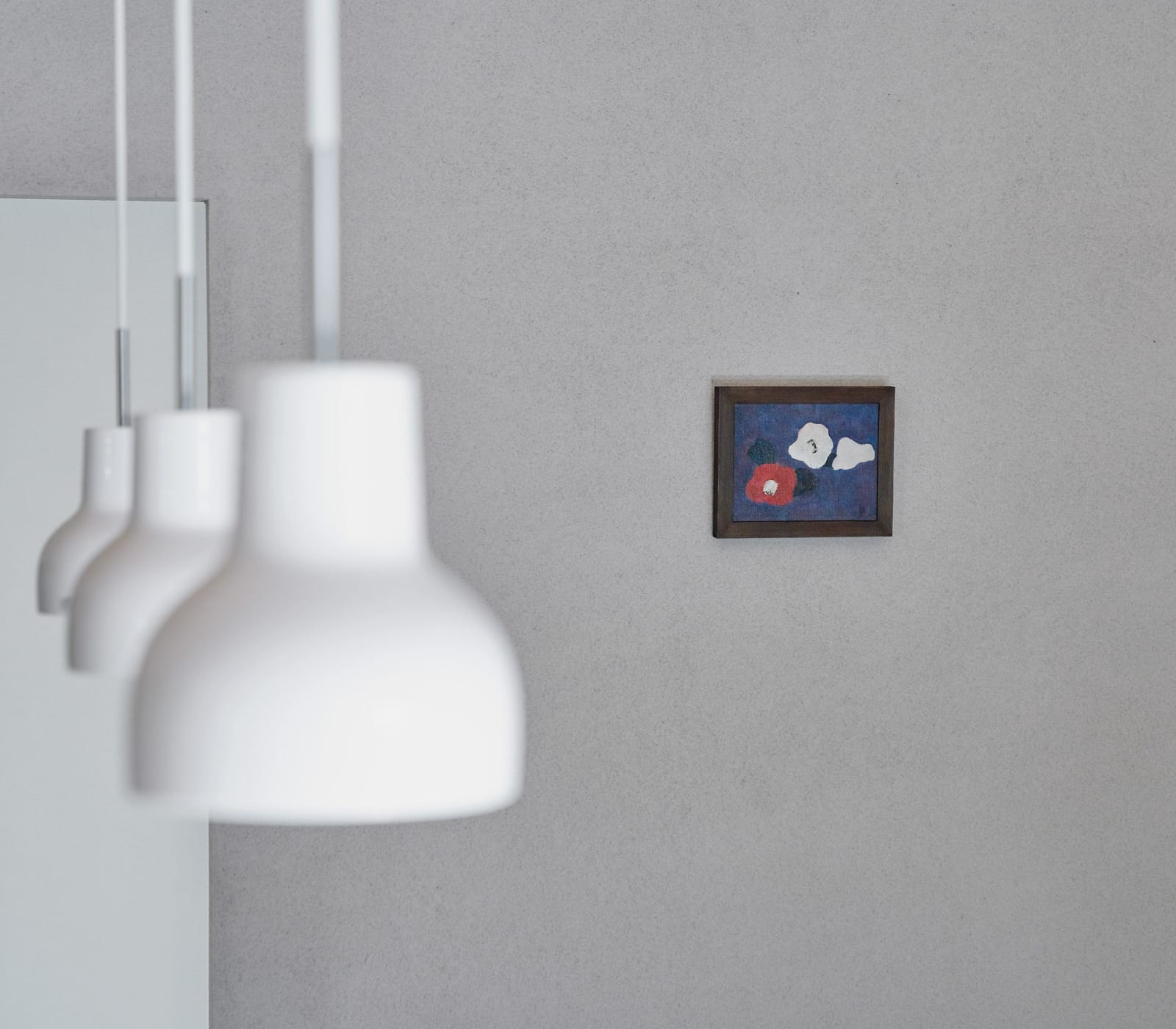Yamaguchi Kaoru (1907–1968)
Red and White Camellias
Oil on canvas, framed
With a certificate of authenticity by Toobi
18.7 x 23.5 cm
23 x 28 cm (overall)
With a certificate of authenticity by Toobi
18.7 x 23.5 cm
23 x 28 cm (overall)
Further images
Literature
Kaoru Yamagouti Catalogue Raisonné. Tokyo: Tokyo Art Club, 2011.
Several lumps of color cluster in the middle of the canvas. The bluish-purple that constitutes the background is not the result of mixing colors together, but rather the artist painted a layer of red first, and then another of blue on top of the other. If we carefully observe the details, we could find that those lumps were left blank in the beginning and filled with colors only after the background was completed. Despite the simplified rendering, the viewer still associates the painted objects with Japanese camellias based on the colors and shapes. However, the camellias are not placed on a table nor in a vase, but shown as if floating in a dimly lit space, creating a sense of mystery and otherworldliness.
There is no date indicated neither on the front nor on the reverse of the painting. However, two of Yamaguchi’s submissions to the First Free Art Artist Association Exhibition of 1937, Hana no zo (Portrait of the Flower) and Ko-roma no tabi (Travel to Ancient Rome), show numerous similarities in terms of coloring. Both of these works also evoke a similar lyrical atmosphere that is hard to put into precise words. One assumes the present work must have been executed around the same time. Yamaguchi’s approach might be a direct outcome of his inner poetic sense.
A lifelong friend of his as well as a renowned art critic, Imaizumi Atsuo, once recalled that he was not aware that his dearest friend was also a poet of a sensitive and passionate temperament until Yamaguchi’s poetry was published after death. According to Imaizumi, “Yamaguchi was a man of few words, he barely even smiled. Yet at the bottom of his heart he was full of emotion. He expressed himself not in words but through painting and poetry. That was his way of showing his love and passion.” In that sense, Yamaguchi’s unsophisticated and pure forms reveal his whole personality. The present work as well aptly demonstrates a moment in the painter’s continuous refining of his aesthetic sensibilities.
Yamaguchi Kaoru (yoga painter; 1907–1968)
Originally from Gunma Prefecture, Yamaguchi graduated from the painting department of the Tokyo School of Fine Arts. Early in his career, he travelled extensively through Europe and Egypt and his works soon became a fixture at the Teiten and Kokugakai exhibitions. He played a central role in establishing the Exhibition of Western-style Art for a New Age (Shinjidai yoga-ten) and co-founded the Free Artists Association (1937) and Modern Art Association (1950). In 1958, Yamaguchi received the Mainichi Newspaper Fine Art Prize and the National Prize of the Guggenheim International Award. In 1960, he was awarded the Ministry of Education Art Prize. He participated in the International Exhibition of Figurative Arts and in 1964 was named a professor of Tokyo University of the Arts.
There is no date indicated neither on the front nor on the reverse of the painting. However, two of Yamaguchi’s submissions to the First Free Art Artist Association Exhibition of 1937, Hana no zo (Portrait of the Flower) and Ko-roma no tabi (Travel to Ancient Rome), show numerous similarities in terms of coloring. Both of these works also evoke a similar lyrical atmosphere that is hard to put into precise words. One assumes the present work must have been executed around the same time. Yamaguchi’s approach might be a direct outcome of his inner poetic sense.
A lifelong friend of his as well as a renowned art critic, Imaizumi Atsuo, once recalled that he was not aware that his dearest friend was also a poet of a sensitive and passionate temperament until Yamaguchi’s poetry was published after death. According to Imaizumi, “Yamaguchi was a man of few words, he barely even smiled. Yet at the bottom of his heart he was full of emotion. He expressed himself not in words but through painting and poetry. That was his way of showing his love and passion.” In that sense, Yamaguchi’s unsophisticated and pure forms reveal his whole personality. The present work as well aptly demonstrates a moment in the painter’s continuous refining of his aesthetic sensibilities.
Yamaguchi Kaoru (yoga painter; 1907–1968)
Originally from Gunma Prefecture, Yamaguchi graduated from the painting department of the Tokyo School of Fine Arts. Early in his career, he travelled extensively through Europe and Egypt and his works soon became a fixture at the Teiten and Kokugakai exhibitions. He played a central role in establishing the Exhibition of Western-style Art for a New Age (Shinjidai yoga-ten) and co-founded the Free Artists Association (1937) and Modern Art Association (1950). In 1958, Yamaguchi received the Mainichi Newspaper Fine Art Prize and the National Prize of the Guggenheim International Award. In 1960, he was awarded the Ministry of Education Art Prize. He participated in the International Exhibition of Figurative Arts and in 1964 was named a professor of Tokyo University of the Arts.





